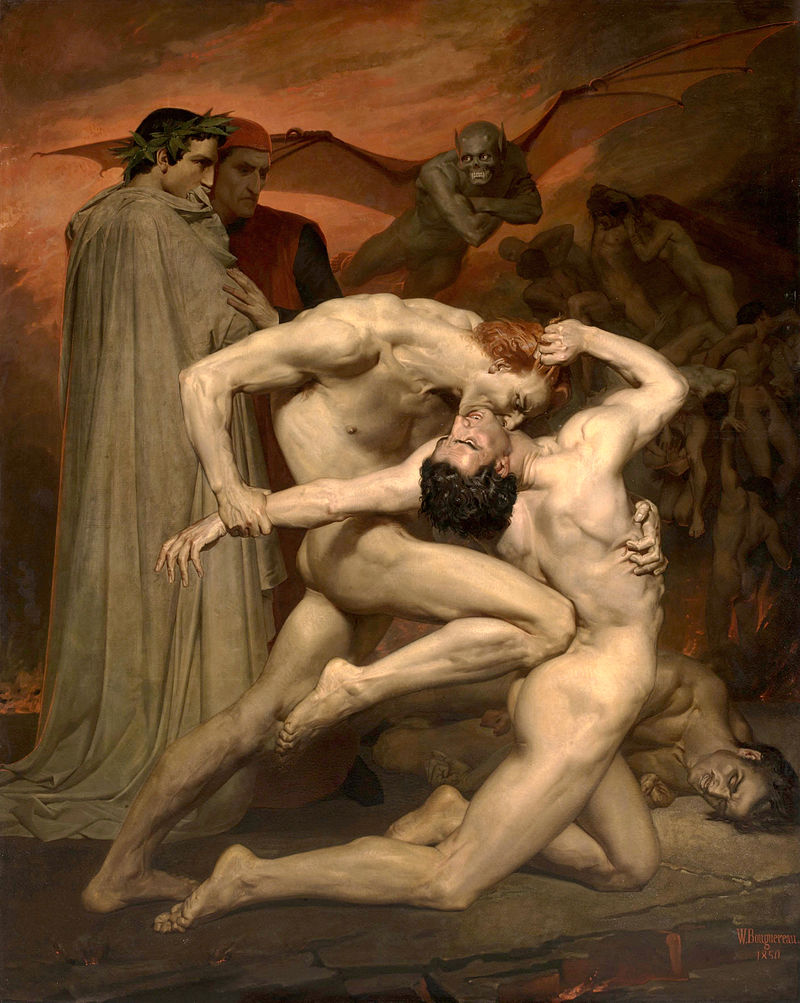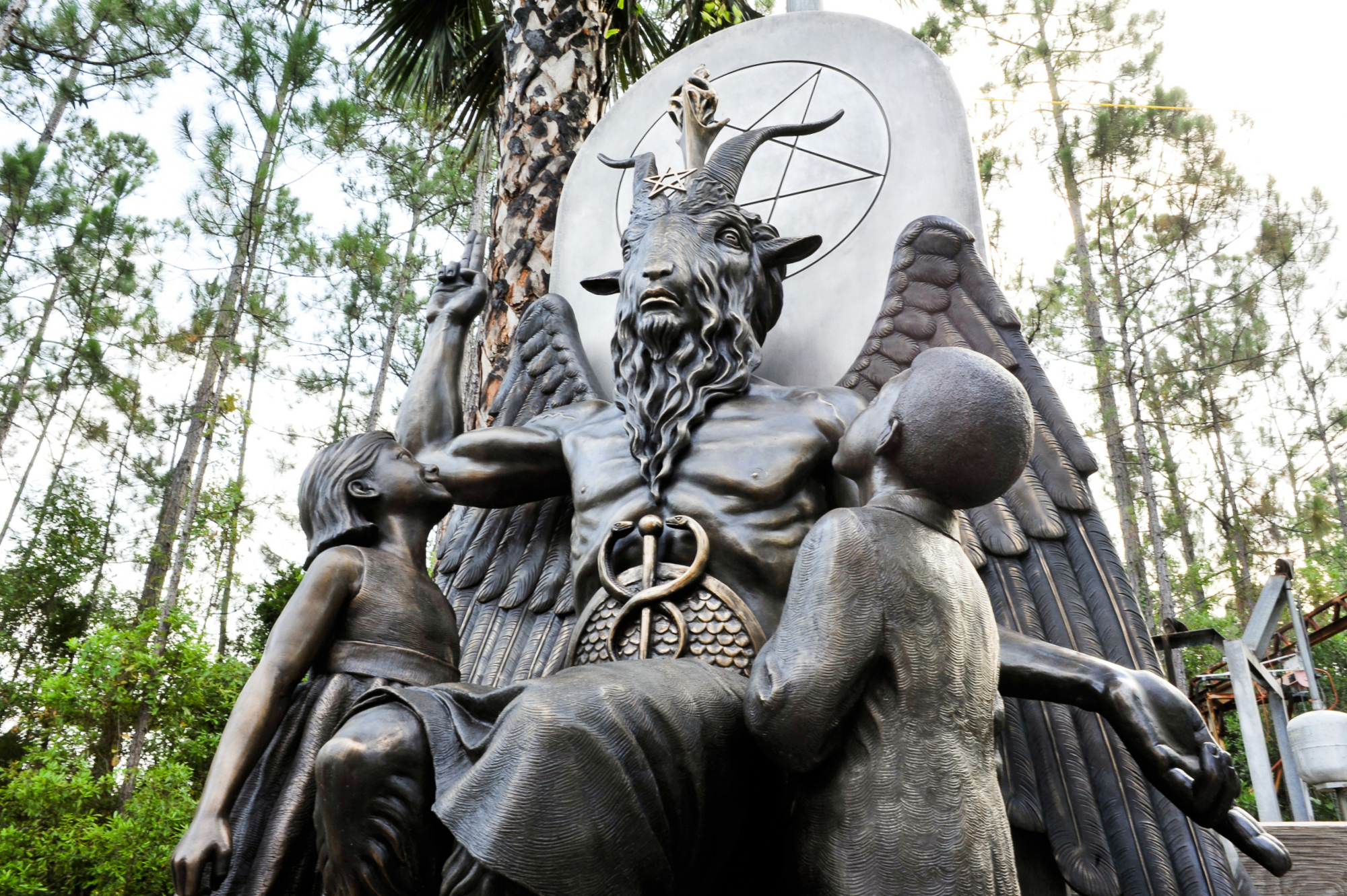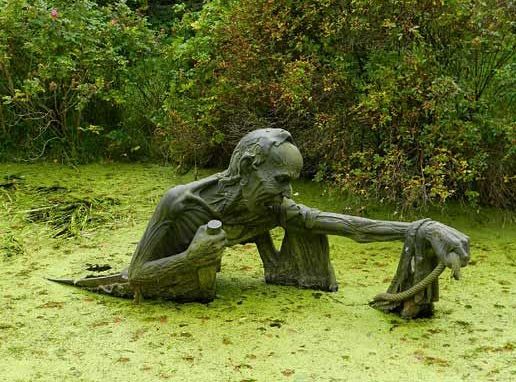20 Works of Art Created From Your Nightmares
This time of year, we often get wrapped up in the traditional lore of horror, and more often than not, we turn to films to entertain us. Whether you're a fan of the horror classics, the suspenseful thriller, the gory torture porn films, or the family-friendly scares, there is literally a film for every type of viewer. I'll dive more into films later on in the month, but right now, I'd like to look at the less modern mediums of art. While these paintings and statues may not be scary in the traditional sense to most, they can often tap into the corners of our nightmares, where our minds run free with devilish creativity and vibrancy. So, let's get medieval on this haunted holiday and take a look at 20 of the most creepy, disturbing, and nightmare fueling works of art you've ever seen.




















There you have it. As you enjoy your scary movies and TV series this Halloween season, don't forget to look around you at other artistic mediums. You just never know what you may see. What are some of your favorite scary or creepy pieces of art? Share them below!

Untitled by Zdzisław Beksiński
This painting of two emaciated beings locked in an embrace is both frightening and heartbreaking. Beksiński's art tends to focus on an anguished psyche, an outpouring of despair and palpable fear, all set in a post-apocalyptic world, as you'll see once more on this list. The artist suffered from severe OCD and sheltered himself in his home and studio and looking at his other works, it's easy to see where his inspiration comes from. Beksiński often left his works untitled with the hopes that the pieces would escape expectations and pre-set interpretations.
Man Attacked By Babies by Gustav Vigeland
Right, at first glance, you see a naked man drop-kicking a baby while he fends off three others. However, there's more to this sculpture than what we see. Featured in the Vigeland Park in Norway, this bizarre piece is one of the less literal in the park. From what I've gathered, Vigeland had to take on a father-figure role to his siblings at a rather young age and it clearly bothered him, as this statue is a representation of his animosity of that role. The babies are actually "genii" spirits that have taken the form of babies. Regardless of what it means, this statue can come across as quite repulsive.
The Water Ghost by Alfred Kubin
It's well known the world over that the oceans, while often beautiful and awe-inspiring, can also be angry and powerful; one of Mother Nature's most destructive forces. Kubin's "Wassergeist" or "Water Ghost," is the perfect depiction of the evil seas. We see five small people in a boat, dwarfed by this massive, ghastly entity, all set in a dark, disturbing sea of water and tumultuous skies. Chaos is likely to follow. I happened upon this painting by accident and it's quickly become one of my favorites. Not sure what that says about me...
The Kiss of Death by Unknown
Oftentimes, Death is portrayed as a winged angel, or even in the style of the Grim Reaper, but for this piece, we see Death as a winged skeleton. The sculptor, who is unknown but thought to be either Jaume Barba or Joan Fontbernat, shows a young man in the embrace of Death, who is planting a kiss on his forehead. Is the young man's expression one of ecstasy or resignation? For a bit of insight, the sculpture sits on top of the grave of the textile manufacturer Josep Llaudet Soler, which includes the inscription "His young heart is thus extinguished. The blood in his veins grows cold. And all strength has gone. Faith has been extolled by his fall into the arms of death. Amen." I'll let you decide what that means.The Nightmare by Henry Fuseli
The next painting in my "I want to add this to my collection" list, The Nightmare often tops the list of terrifying paintings. The imp-like creature sitting atop the woman is often confused for a devil or demon, but it's actually an Incubus, a spirit that is said to sit on top of people while they sleep (...among other things) which leads many to believe the woman in whit is actually just sleeping. According to Fuseli's biographer and friend John Knowles, the horse with glowing eyes was not originally part of the concept he first saw but was later added by Fuseli while he completed the painting. Why the horse, you ask? Some think it's an attempt at a punny (Night-Mare...get it?!) attempt to connect the title to the horse. However, as Samuel Johnson’s A Dictionary of the English Language from 1755 defined it, a mare or “mara, [is] a spirit that, in heathen mythology, was related to torment or to suffocate sleepers." Therefore, it's thought that the painting directly refers to the feeling of the chest pressure felt during a dream state. Crazy, right?!
Blue Mustang by Luis Jiménez
What?! This is a beloved figure in the Denver community! While that may be true, this could quite possibly be one of the most accidentally creepy pieces of art in modern history. Nicknamed Blucipher by locals, this cast-fiberglass sculpture has a bit of a dark history. In 2006, the artist Jiménez was killed when the head of the sculpture fell on him and severed an artery in his leg. The piece was finished by Jiménez's staff, family, and race car painters Camillo Nuñez and Richard LaVato. Two years later, the art piece was installed at Denver International Airport. The blue color tones, the wild pose, and the glowing red eyes take this from intimidating to frightful pretty quickly.
Saturn Devouring His Son by Francisco Goya
This is the first depiction of Saturn having a good nosh on his son on this list. We'll see another take on the topic a bit later. This dark painting by Goya is one of the 14 Black Paintings found on the walls of his home and was later transferred to canvas, where you can find it at Museo del Prado in Madrid. The image depicts the Greek Titan Cronus, or Saturn when Romanized, who, fearing he'd be overthrown by one of his children, ate all of his children when they were born. The wild look in Saturn's eyes is one of fear and chaos, showing he's willing to literally do anything he can to keep from being dethroned. Since Goya never intended the piece to y publicized, we have no notes as to the meaning, but many have speculated. Those range anywhere from a conflict between youth and old age, time-devouring all things, or even an allegory of the situations happening in Spain during the time. No matter the meaning, this painting is definitely one of the most disturbing in history.
The Split Man by Victor Langheld
This shockingly violent, yet meaningful statue can be found in Victor’s Way Indian Sculpture Park in Ireland. The park is filled with sculptures by Victor Langheld and is often described as life-changing when you visit. Each one of the sculptures offers up a lesson on choosing the right paths in life. The Split Man depicts a young man literally carving himself in two, intended to represent the torment of procrastination to find your own happiness and your intended path. It's hard to ignore the anguish shown in the young man's face and I think most of us have been at this crossroads in our own lives and know the pain that can come along with it. This one can hit a little too close to home for some.
Dante and Virgil In Hell by William-Adolphe Bouguereau
If you've ever read Dante's Inferno, then you know it's an all too real journey through hell, in all its dark, disturbing glory. There are many standout passages from the poem, and they often don't leave much to the imagination. Much like Bouguereau's take on Dante and Virgil witnessing a battle between the damned souls of an alchemist and heretic named Capocchio who is being bitten on the neck by Gianni Schicchi who had used fraud to claim another man's inheritance. You can also see a demon flying in the background, looking on with delight. The oil painting is quite realistic, showing incredible detail in muscles, tendons, teeth, and hair. In fact, the artist even goes so far as to distort the figures just enough to make the figures even more haunting. You can view this incredible piece at the Musée d'Orsay in Paris.
Hanging Boy by Unknown
This disturbing little gem can be seen on a wall in the town of Ghent, Belgium. Despite my efforts, I really can't find any information on this creepy sculpture. The only thing I can find is the artist is unknown. I would really like to find out the intent of this one, other than this is what happens to kids who don't behave.
Night Creeper by Zdzisław Beksiński
Hello Beksiński, we meet again! Much like his Unknown piece above, Night Creeper takes us into yet another post-apocalyptic world, where the landscape has been decimated, leaving everyone and everything to fend for itself. This lurking creature is something that would crawl right out of our nightmares; a combination of something from the Silent Hill video game and a Tool video. I think the award-winning director and creator Guillermo Del Toro described Beksiński and his works best, saying "In the medieval tradition, Beksinski seems to believe art to be a forewarning about the fragility of the flesh – whatever pleasures we know are doomed to perish – thus, his paintings manage to evoke at once the process of decay and the ongoing struggle for life. They hold within them a secret poetry, stained with blood and rust.
El Tiempo by Jorge Marin
I happened to come across this stunning piece by accident and I instantly fell in love with it. El Tiempo is a part of a public art installation by Jorge Marin and you don't often see it categorized as scary, but I think it would qualify as startling. The hollow eyes, which allow the light to shine through and the powerful crouching position give El Tiempo a daunting look. The series of sculptures in Houston, TX were meant to serve as protectors and with El Tiempo, he is damaged, with a broken skull and severed arms, but is still at the ready to defend the city.
The Garden of Earthly Delights by Hieronymus Bosch
At first glance, this triptych painting from Bosch appears to be a colorful expression of happiness and, well, delights. But when you look closer, you can see what many scholars interpret as an admonition of worldly fleshy indulgence and a dire warning on the perils of life's temptations and even an evocation of ultimate sexual joy. The panels, when examined from left to right, represent Eden, the Paradise Lost, and the Last judgment on the right. It's the latter where things get particularly dark and almost disturbing, with images like a giant bird-eating human that is farting smaller birds and musical instruments inserted into various orifices. This is one of those pieces where the more you look at it, the more disturbing it becomes.
Statue of Baphomet by Mark Porter
I don't think I need to go into too much detail as to why this particular piece is on my list. The statue does have a rather interesting origin, however. In 2014, the Satanic Temple began a crowdfunding campaign to have the piece made with the intent to have it installed in the Oklahoma State Capital building alongside a new Ten Commandments Monument. Artist Mark Porter forged the sculpture in Florida using the drawing by Eliphas Levi as a basis for Baphomet. Guests who wanted a ticket to the unveiling that occurred in Detroit in 2015 were required to "sell their souls to Satan" in order to keep out any protesters who may want to disrupt the event. After a lawsuit, the Ten Commandments Monument was removed and the Satanic Temple withdraw their quest to have Baphomet installed. In 2018, the Satanic Temple brought a lawsuit against Netflix for using a likeness of the statue in the hit series The Chilling Adventures of Sabrina. It can currently be found in the Salem Art Gallery in Massachusetts.
Saturn Devours One of his Sons - Peter Paul Rubens
Ladies and gents welcome back the ravenous Saturn! Where Goya's more modern version (1819–1823) above is a bit more interpretive, Rubens' original take on the topic from 1636 is quite a bit more visceral, where you can see Saturn actually tearing at the flesh of his son, with the anguish and pain of the child is quite evident. The painting itself is quite a bit more realistic and in the Baroque style of the time. The painting was completed shortly after Rubens spent time in Italy with famed artist Michelangelo and his influence is quite evident. It's hard to look past the pain in that baby's face, though, isn't it?
The Ferryman’s End by Victor Langheld
We're headed back to Victor’s Way Indian Sculpture Park for this truly haunting statue. The Ferryman's End is yet another metaphor for a crucial point in life. Langheld had this to say about this tragic piece: "The sculpture of the Ferryman’s End is a metaphor for the individual who is losing touch with the real world, personal or general." As with The Split Man above, the artist made a point of depicting pain and sadness on the subject's face. These are hard times in life, trying to grasp a reality that is just out of reach and the weight of the world is dragging you down.
A Puppet for the Niece by Santiago Caruso
Kids can be pretty creepy, right? Santiago Caruso, a modern artist focusing on surrealism, shows us just how creepy they can be with his macabre work A Puppet for the Niece. Caruso uses very little color in his paintings, but he is a master of light, forcing you to focus on what he wants you to. In this case, it's a young girl disemboweling a puppet in a basement. Totally normal. The deep-set, dark eyes of the girl give her a very sinister look. I'm about 75% certain I've had this nightmare before. If you really want a delve into the darkness, take a look at some of Caruso's other pieces. You'll laugh, you'll cry, and probably won't sleep for a while.
The St. Bartholomew Statue by Marco d'Agrate
The term "attention to detail" gets thrown around a lot these days and for obvious reasons. You often see the detailed work in art, but few artists go into as much detail as Marco d'Agrate did with his St. Bartholomew Statue, which can be found in the Milan Cathedral. The figure depicts St. Bartholomew, who was one of the Twelve Apostles of Jesus and was later skinned alive and beheaded. This particular piece shows the saint after his skin was removed. In fact, what many think is a robe is actually his skin. When you look at his hand and feet, you can see the sinewy tendons and muscles. The piece is both beautiful and terrifying at the same time.
The Hands Resist Him by Bill Stoneham
More creepy kids! This painting has a very unique history to go along with the subject. The painting first appeared at an art show featuring the work of Stoneham. John Marley, notable for his role as Jack Woltz in The Godfather, purchased the painting at that time. After his death, the piece was found by an elderly couple at the site of an old brewery, according to their eBay listing. Yeah, that's right. In 2000, an auction listing appeared on eBay, which included a disclaimer absolving the seller from all liability if the painting was purchased. The couple claimed "that the painting was cursed or haunted. Included in those claims were that the characters in the painting moved during the night and that they would sometimes leave the painting and enter the room in which it was being displayed. Also included with the listing was a series of photographs that were said to be evidence of an incident in which the female doll character threatened the male character with a gun that she was holding, causing him to attempt to leave the painting" (Wikipedia). According to the artist, the object presumed by the eBay sellers to be a gun is actually nothing more than a dry cell battery and a tangle of wires. In what some feel to be a connected story, the owner of the gallery in which the art show was held died within one year of coming in contact with the painting. Coincidence?

The Cloak Of Conscience by Anna Chromy
Remember when you were a kid and you'd throw a sheet over your head and pretend you were a ghost? That's kind of what this reminds me of. However, as you examine this sculpture, which is carved from a single piece of white marble that was excavated from the Michelangelo Quarry in Carrara, Italy, where Michelangelo sourced his marble for his iconic David, the void where a face should become more prevalent and haunting. The sculpture is also deceivingly large, standing at just shy of 16.5 ft. tall. By comparison, the famed David is just short of 17 ft. There are several versions of this figure around Europe, which is said to have first appeared in Chromy's 1980 painting 'To Be Or Not To Be', which in turn had been inspired by the play Jedermann by Hugo von Hofmannsthal and Don Giovanni by Mozart. For something so simple, The Cloak of Conscience sure is thought-provoking.There you have it. As you enjoy your scary movies and TV series this Halloween season, don't forget to look around you at other artistic mediums. You just never know what you may see. What are some of your favorite scary or creepy pieces of art? Share them below!

Comments
Post a Comment